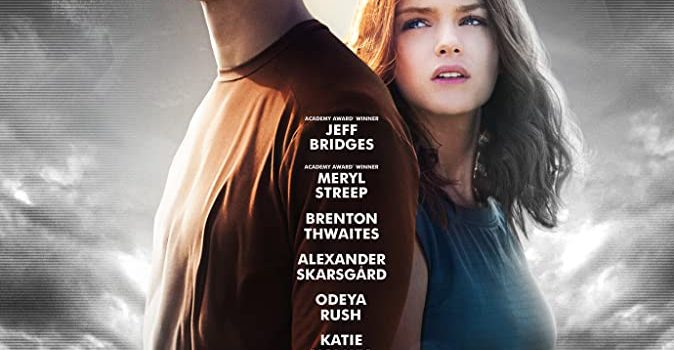‘A Black-and-White Movie, in More Ways Than One’: A Review of The Giver
by Gary Westfahl
The chief virtue of The Giver, perhaps, is that it will encourage more people to read its inspiration, Lois Lowry’s The Giver (1993), a novel for young readers that is nonetheless profound and magical and would not be out of place in a college class focused on utopian and dystopian literature. If the film as a whole is less impressive, that is largely because the executives governing contemporary Hollywood, like the oppressive Elders of Lowry’s world, relentlessly enforce a set of rules which drain all of the color and individuality out of every item that comes under their control. Screenwriters Michael Mitnick and Robert B. Weide could justifiably protest that they were generally faithful to Lowry’s story, but their departures from the novel are both telling and subtly destructive to its spirit and message.
From the viewpoint of her protagonist, twelve-year-old Jonas, Lowry evocatively described a future society that has eliminated conflict and violence by suppressing all human emotions and idiosyncrasies – even color vision and music have been taken away, presumably for fear that these might arouse dangerous passions. Only the Receiver of Memories is allowed to remember the full variety of past human experiences, so he can provide advice to the community’s Elders, and Jonas, chosen to become his successor, begins to absorb the memories of the Receiver – now termed “the Giver” – as he transfers his memories to Jonas. Although both Jonas and readers come to recognize that this apparently idyllic world is actually oppressive and unsatisfying, Lowry was careful to convey that its creators had excellent reasons for their initiatives which could be intelligently defended, and the superiority of our own society remains a matter of debate. Jonas’s final decision to leave his community, allowing his memories to be released to everyone, was pictured as an event that will cause his society to evolve, yet not be destroyed; after he departs, he easily avoids a few pursuing planes, but it is unclear at the end of the novel whether he will survive to find happiness in a group more to his liking (though we learn that he does in one of Lowry’s loose sequels to this novel, Messenger [2004]).
Reading this summary, anyone could have predicted how a team of producers would react: no, no, no, ambiguity and uncertainty are bad; we must have heroes and villains, the sharp, black-and-white conflict of traditional melodrama; from the get-go, it must be crystal clear that this society is 100% evil; rather than vague, unseen oppressors, we must introduce sinister characters that audiences can despise as they oppose and threaten Jonas at every moment; instead of his rather placid escape, hey, we could suddenly turn all of those bicycles that people are riding into motorbikes and have an exciting chase scene – that would be original! – and, of course, we somehow have to slip in a love story for all the women in the audience and provide the story with a completely happy ending.
So, in the film, Jonas (Brenton Thwaites) and his friends are elevated to the age of eighteen, so that his friend Fiona (Oyesa Rush) can become his girlfriend and do some passionate kissing; the Chief Elder (Meryl Streep), who only appears once in the novel, is refashioned as a major character and as Jonas’s chief opponent, constantly conspiring against him and other potential rebels in the manner of Donald Sutherland’s President Snow in The Hunger Games and its sequel (reviews here and here); Jonas’s other friend Asher (Cameron Monaghan), a fun-loving fellow who becomes the Assistant Director of Recreation in the novel, is here assigned to serve as a drone pilot and grows somber and unlikable as he tries to prevent Jonas’s escape and chases him through the countryside; and Jonas’s mother (Katie Holmes), only mildly unsympathetic in the novel, eagerly enlists in the film’s Society of Super-Villains to bedevil Jonas and Fiona.
All of these changes have reverberating, and damaging effects, on the story. In the novel, despite his youth, Jonas was presented as a remarkably intelligent young man; here, Thwaites’s Jonas seems annoyingly stupid, as he openly and repeatedly violates his orders to keep his training a secret by trying to share each of his new discoveries with family members and friends. But he has to do something to attract the attention of the Chief Elder and provoke her next inimical move. The Chief Elder appears to be capable of observing every single one of Jonas’s actions – except at the times when she actually needs to – and her ruthlessly efficient minions suddenly turn into incompetent Keystone Kops when they attempt to capture Jonas. But of course, he has to escape somehow against all odds, even though one successful maneuver is so incredibly implausible that Jonas is obliged to describe it as “a miracle.” The Chief Elder’s eventual decision to arrest and imprison the Giver (Jeff Bridges) seems absolutely senseless, as it is clearly violates the rules and is also unnecessary, since she can keep him under control in other ways. But it does show how thoroughly evil she is, just in case there were still a few people in the audience who didn’t yet realize that she was a dirty rotten so-and-so.
Other ways that Lowry’s story has been altered are relatively inconsequential, but bemusing nonetheless. Everyone knows that Bigger Is Better, so there are 150 youths, not 50 youths, in Jonas’s graduating class, and the buildings one observes seem larger and grander than one would expect from reading the novel. The film eliminates Lowry’s vague geography and places all of the communities on a high plateau, with the Giver’s house dramatically positioned at its edge. The Giver conveys his memories to Jonas by grabbing his arms, instead of touching his back, because, you know, characters who interact are supposed to maintain eye contact. To quickly convey that the baby Gabriel (Alexander Jillings and James Jillings) is really special, he is given a mark on his wrist which corresponds to a similar mark on the Giver’s wrist and Jonas’s wrist (yet if there is indeed a birthmark which distinguishes someone as a potential Receiver of Memories, such an individual would never, like Gabriel, be short-listed for infanticide).
Still, while one can complain at length about the ways that the film fails to do justice to Lowry’s novel, published for readers in 1993, a film adaptation also has to be considered on its own terms, as an original creation designed for viewers in 2014. And, as it turns out, the film actually has some interesting things to say about the young people who were undoubtedly envisioned as its major audience.
As a minor matter, the film is first a commentary on how advances in technology have altered people’s perceptions of film. Since The Giver is a movie that begins in black-and-white and then shifts to color, corresponding to Jonas’s gradual acquisition of color vision, one invariably recalls the classic film which did the same thing, The Wizard of Oz (1939). But in 1939, black-and-white films were standard and color films were rare, so it was natural for the filmmakers to represent the real world of Kansas as black and white and to provide color for the fantasy land of Oz. But today, virtually all films – even videos taken by smartphone cameras – are in color, and black-and-white film is an oddity, so it is now appropriate for director Philip Noyce to represent Jonas’s false, constricted society as black and white, while the colors he learns to see represent the real world that he is discovering. This, I think, offers an interesting opportunity for contemporary makers of fantasy and science fiction films: to make their imagined environments seem strange and unreal, it might make sense to film them in black and white, or in the forms of tinted black and white that once were occasionally employed. I recall that in The Angry Red Planet (1959), the tinted red scenes on the Martian surface were surprisingly disconcerting; having modern actors suddenly find themselves in a black and white world – or a blue and white world – might be effective as well.
The film is also far more emphatic than the novel in arguing that Jonas’s world is tragically lacking in cultural diversity, as well as other sorts of variety. Lowry notes only that “There was a time … when flesh was many different colors,” but “Today flesh is all the same.” Yet different cultures as well as different races figure prominently in the memories that Jonas receives; except for his initial ride on a sled to an isolated house and a glimpse of civil rights protesters, virtually every scene seems to take place in a different country and foregrounds exotic, colorful ceremonies and activities. And in this international spirit, the film accords perfectly with contemporary values that were not yet dominant in 1993. Still, to epitomize everything that is missing in this society, the film does fall back on the comfortingly familiar image of an old-fashioned Christmas, complete with the singing of “Silent Night.”
The film further reveals that its community, in at least one respect, is precisely similar to our own, in that there is a desire to protect young people from painful emotions and experiences, and the film suggests that this is perfectly appropriate. After all, the person previously chosen to become the new Receiver, Rosemary (Taylor Swift), was so disturbed by her first exposure to unpleasant feelings that she immediately asked to be killed, and Jonas also becomes rather unhinged after one jarring memory and announces that he is quitting, unable to endure any more of the same. (One scene underlines that the reactions of Rosemary and Jonas were eerily similar.) If youths are indeed this fragile, as both this film and many contemporary educators would argue, it seems incongruous that Jonas resolves that all of his awful memories must be shared by everyone – even though, as is made explicit in the novel, the Giver will be staying behind when Jonas leaves to function as a sort of “grief counselor” to the suddenly distraught citizens.
The film also stresses the negative effects of pain through the character of its Giver, who is significantly different from Lowry’s Giver. In the novel, he is unfailingly kind, gentle, and helpful to Jonas; he always answers his questions, and never gets angry at him. In contrast, Bridge’s Giver is gruff and sometimes secretive; he refuses to answer a few questions; he sometimes snarls at his protégé; and he regularly conveys that he doesn’t want to be where he is, doesn’t want to be doing what he’s doing. Perhaps this was all just another way that the filmmakers sought to add drama to the story, or to remind audiences that he continues to suffer from the loss of Rosemary, but it also suggests that the Giver is suffering from the cumulative effects of absorbing and retaining all of that pain and torment, making him unable to relax, enjoy himself, and be nice to other people. Still, I felt that this revised version of Lowry’s character was unfortunate, making the Giver much less sympathetic, though I suspect the root cause was an actor who took the wrong approach to his performance and a director who could not criticize him because, as one of the film’s producers, he was also his boss.
(To digress, this suddenly makes me think that the film was understandably, but tragically, miscast; Bridges and Streep should have switched roles. After all, there is no reason why the Giver has to be a man, and Streep surely could have made the character more nuanced and appealing; instead, her talents were wasted on the undemanding chore of portraying a one-dimensional villainess. And Bridges seems more suited to portray a determined, dedicated opponent than an avuncular advisor. There was also a missed opportunity in the film’s misuse of Taylor Swift; surely, if the producers had resolved to cast a famous singer as someone with musical talent, they should have given her a song to sing. Better yet, they should have hired her to write and perform an original song that probably would have been far more memorable that Ryan Tedder’s uninspired “Ordinary Human.”)
Finally, while it is usual for commentators to focus on the issues that a film is concerned about, it is very interesting to notice one conspicuous matter that this film is not concerned about, namely, its society’s pervasive surveillance technology. As in the novel, all citizens are constantly under observation and, if they are misbehaving, a speaker impersonally prods them to stop; the film adds the information that all of their actions are also being videotaped, so that when she asks, the Chief Elder can obtain and watch a filmed compilation of every single one of Jonas’s actions since the time he was chosen to become the new Receiver. But nobody complains about this; nobody ever says, “I’m tired of living in a society that is constantly watching everything I do and say”; this society is said to need more emotions, more pain, more diverse experiences, but no one seems to want or need more privacy. This is, to be sure, a film aimed at younger people who, the pollsters keep telling us, seem far less concerned than their elders about protecting their private information from public scrutiny, and even many adults are coming to accept the notion of installing cameras to record all activities in public places. The film suggests that, as an inevitable extension of these trends, people in the future may embrace having cameras in their private places as well. The sound you hear is George Orwell, doing a 360 in his grave.
The film is also willfully circumspect regarding the role of religion in past and future human societies, despite faint indications, already referenced, that it is also a Christmas movie, and hence a Christian movie. In the novel, there was always something Christ-like about the manner in which the Giver absorbed painful memories in order to allow other people to avoid pain; he identifies his favorite memory as an extended family’s Christmas celebration; and the baby’s name, Gabriel, is also the name of the angel who announced Jesus’s birth. The film goes a bit further: one scene indicates that all of the trees in Jonas’s society are artificial, with branches that screw in, like artificial Christmas trees; as he learns to perceive colors, the predominant colors he sees are red and green; and Jonas is finally observed approaching a home decorated for Christmas with a baby that is precisely twelve months old, and hence was born on or around Christmas. Perhaps, since Jonas announces that he will return, he will bring Gabriel with him so he can become a new Receiver of Memories who, in the manner of Christ, will continue to provide some comfort for a society that has now absorbed some, but not all, of humanity’s painful and variegated memories of the past. Yet in a society dedicated to celebrating diversity, including diverse religions like Christianity, Judaism, Islam, Buddhism, and Hinduism, a filmmaker may now feel obliged to make any references to a specific religion very subtle indeed, so much so that the pattern I discern here, I readily admit, may be entirely coincidental.
This related to one other way in which The Giver seems dull and monochromatic: its relentless avoidance of controversy. Perhaps the film declined to criticize its society’s surveillance policies for fear of seeming too political, just as the Christmas references were muted for fear of seeming too religious. And it is always safer to direct one’s ire at fanciful, imaginative villains like the Chief Elder than to openly attack any of the real villains (choose your own examples) who are actually oppressing contemporary citizens. This, one might say, represents Hollywood’s Plan for Sameness, which as Jonas learned does get tiresome after a while.










I had read The Giver as an adult but forgotten practically everything.
Not impressed by comparisons, I can tell you that the editing of the memory sequences contains much more of the movie than discusses here. Also, that the Chief Elder’s villainy is not that apparent but that the Giver’s revolutionary plans are. It is not an accident that the Chief Elder’s new memory fastens on war and it is an internal commentary.
The movie does seem to say that truth is proportional to the intensity of emotion, while dodging the question of how that plateau can support a society without some form of population control. As an adult I see problems with this that interfere with feeling triumphant at the revolution’s victory.